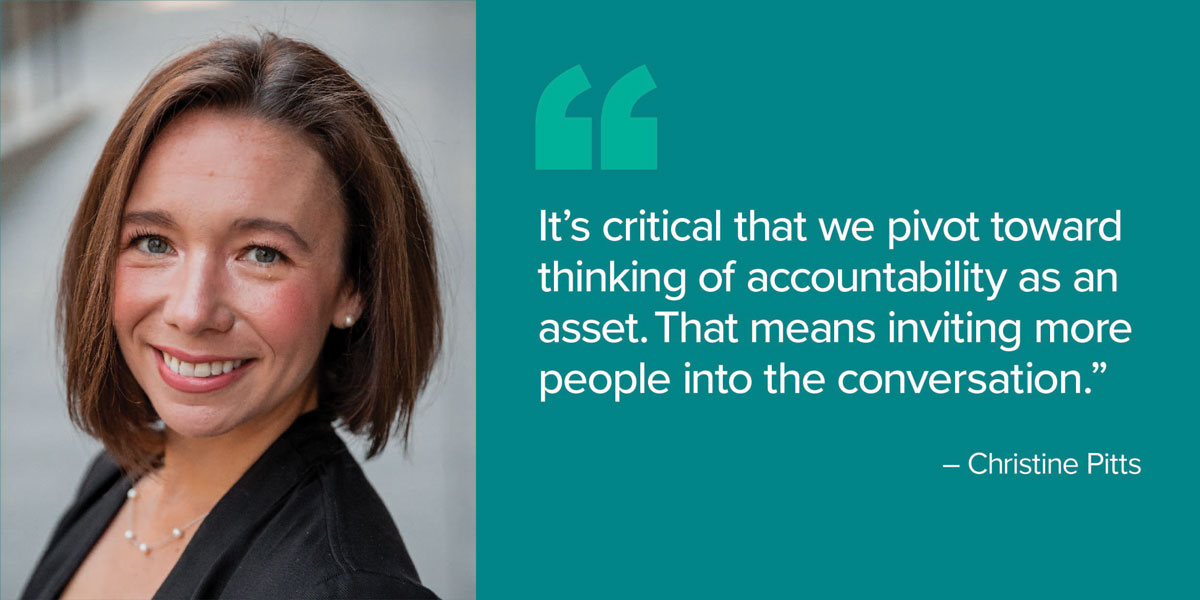Embracing Accountability in Education

Early in my career, I was a third-grade teacher in North Carolina. By federal law, third grade is the first year that students are required to take their end-of-year, statewide standardized assessments. Those test scores meant a lot to me. Of course, I wanted my students to succeed. But also, in North Carolina at that time (as in many states) the end-of-year test scores were factored into our evaluations as teachers. Like many educators, I had mixed feelings about that. After all, many variables affect student performance on assessments—not all of them within a teacher’s power to influence.
This experience with assessments as a classroom teacher led me to study governance and accountability during my doctorate. I wanted to understand how states design their accountability systems to support teachers and students, as well as to hold our systems accountable. For the past fifteen-plus years, I’ve worked on unpacking how states like North Carolina (and Oregon, where I had grown up and where I taught next) ensure they’re meeting federal requirements while also being transparent to local communities.
It’s critical that we pivot toward thinking of accountability as an asset. That means inviting more people into the conversationFor me, that’s what school accountability is all about—making sure that everybody, from families to business leaders to community partners, understands how schools are working and whether they're doing their job at both the state and district levels. I focus on accountability because it is a pathway to ensure the prosperity of our community and our children.
Accountability as an Asset
Leaders and teachers perceive the translation of federal accountability laws at the local level as something to be afraid of, like I did as an early-career teacher. It’s critical that we pivot toward thinking of accountability as an asset. That means inviting more people into the conversation, instead of just leaving it to state education agencies and school districts to discern. Everyone—business and nonprofit leaders, educators, and families—should care about school accountability, whether they have a school-aged child or not, because it impacts the success of our communities.
I went from being an accountability skeptic to, now, working to reframe accountability with state and local leaders to help make sure the measures and tools work for them. We need to shift how we’re collecting data and implementing accountability, because teachers often have a right to be skeptical. Teachers, families, and students are so many degrees removed from accountability discussions that they are unclear about how the information can support their daily work.
Many states, including Oregon, are discussing how to improve their statewide funding formulas for public education. However, to capture the most value from our investments, education funding must be balanced with accountability measures. We need to invest more in education and we need to ensure that our investments are getting us the outcomes that our children and society deserve. If we’re asking states to provide more funds for schools, we also need to design more reliable, meaningful, and coherent accountability systems. This includes ensuring that teachers have the resources they need to provide high quality instruction and that the entire community shares ownership of our challenges and successes.
Using Data in School Governance
School systems need to use many kinds of data to ensure that accountability is governed through continuous improvement and an explicit focus on equity. During the pandemic, when we had a year with very few standardized assessments, it became clear that without data our children become invisible at school. When you stop collecting and publicly sharing data, schools can seem like black boxes—we don’t know what’s going on inside and we don’t know how our children are faring. One silver lining, though, is that many states are following through on their plans for longitudinal data systems and public data dashboards. In doing so, we also need to ensure that the data is disaggregated by appropriate subgroups and that those outcomes are reported publicly. Otherwise, we risk masking disparities or overgeneralizing our successes.
Data systems are complicated because they require collaboration across government agencies. States often collect a lot of data, but then they have to decide what to make public, and how. That’s a very important conversation, because what you make public is what you’re saying you’re going to pay attention to—your priorities and what you value. To ensure equity, it’s essential that culturally specific nonprofits, teachers’ associations, student advisory groups, and families are involved in making those decisions. Data and accountability can help state agencies and local schools tell their collective stories with all their complexities, challenges, and wins.
Joining Education Northwest
I’m excited to join Education Northwest consulting as a Senior Fellow, partly because I grew up in Coos Bay, Oregon, and am now raising my four kids in Portland. I think the Pacific Northwest has many strengths and assets that get overlooked in the national conversation. Education Northwest has been doing powerful research and policy work in our region for decades.
I’m going to dive into helping to elevate trends about policies across projects, especially those related to data, governance, and school accountability. I’m looking forward to finding connections between Education Northwest’s work—on literacy leadership and on strategic plans related to equity and multilingual learners, for example—and what’s happening in communities across the country.
Many states are grappling with very similar issues in education—especially how they are supporting students in this post-pandemic journey. Accountability, governance, and how to use data are cornerstones for this work. As an organization, we can help build cross-state coalitions and hold space for them to have conversations, compare plans, and talk about the barriers they experience. I think it’s the right time to build networks for states to learn from one another to improve education for students, teachers, and communities.
